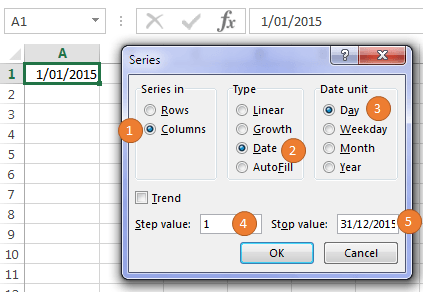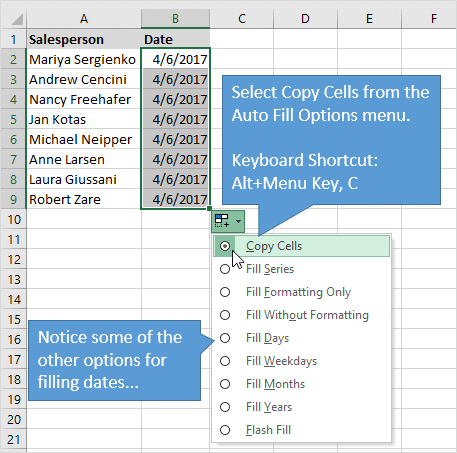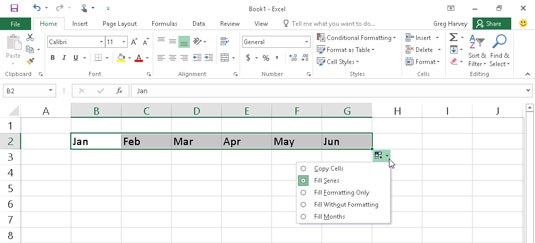

Use the Excel Pick From List function to obtain consistent descriptions for fields that you want to total with Excels Pivot Table function and then create a Pareto or bar char. Next, select both cells and drag the fill handle or the + sign that comes up in the lower right corner of the selection to extend the series downward or. Use the Custom Fill Series to save time when creating your data sheets. Right click on the cell below the hidden row to view and select from the pull down list. To hide it, select the rows with your list, then click on Format, Row, Hide. You can show your master list or hide it.
Select one and the cell will be populated with that value. Excel will bring a up a pull down of options from your list.  Right click on the next cell under the list and select "Pick From List". Create your finite list of error codes, cities, etc. When setting up a spreadsheet for others to populate, you can create a finite list of selections for them to use and then have them access the list using Excel's Pick From List function. Do you know how many ways there are to spell Colorado Springs? (Colo Springs, CO Springs, Colo Sprgs, CO Sprgs, etc.) How about Accounts Payable? I am sure you have your own personal favorite. Unfortunately, the Pivot Table requires values to be EXACTLY the same to summarize them. Excel Pick From ListĮxcels Pivot Table function can help you summarize large spreadsheets of raw data. For more information on this functionality go to Excel's help index and type in Custom, Fill Series. Then click on Add again to create the list. If you don't already have these values in a spreadsheet go to Tools/ Options/ Custom Lists and select Add. Denver), then select the cell with Denver in it and drag down the lower right box to the next four cells. To access your new list, type the first value in the list (i.e. Go to Tools/Options/Custom Lists and select Import then OK. Click and drag over the cells with the cities to select them. If you already have these cities typed in a spreadsheet do the following: To autofill letters from A-Z, you need to use a formula. When you use this with letters of the alphabet though, it doesn’t work. This is also useful for filling formulas. Denver, Los Angeles, New York, Orlando, Phoenix. Click and drag it all the way down and it will fill in the rest of the months for you. Let's say you do lots of charts with the same five locations. You can also create your own Excel custom list. Select both cells and then grab the lower right box and drag down as many rows as you want. Here is an example of creating a column with every other day. Excel will detect a pattern and follow it. You can also create a pattern and Excel will follow it. Try this with Monday thru Friday, 1, 2, 3 or Part 1, Part 2, etc. Pretty simple isn't it? Drag the box down 23 rows and get Jan-05 to Dec-06. Presto you now have column with Jan-05 to Dec-05. Click on the box and drag it down 11 rows. Now click on the cell and notice that the lower right corner has a box. Here is how Excel's custom fill series works. Let's say you need to create a column with Jan-05 to Dec-05. How many times have you typed Jan, Feb, Mar in a column? Do you create lots of charts for each plant or hospital in your company? If you are typing the same thing over and over again, there is a better (and much faster) way! ChartObjects(mChartName).(1).Free Excel Tips » Custom Fill Series Excel Fill Series and Pick From Custom List Custom Excel Fill Series ChartObjects(mChartName).Chart.SeriesCollection(LegendCount - mLegend + 1). ChartObjects(mChartName).Chart.SeriesCollection(LegendCount + mLegend). =. ChartObjects(mChartName).Chart.SeriesCollection(LegendCount + mLegend).Values = "=" ChartObjects(mChartName).Chart.SeriesCollection(LegendCount - mLegend + 1).Name ChartObjects(mChartName).Chart.SeriesCollection(LegendCount + mLegend).Name =. The Series window can be reached via the ribbon in Excel version 2007 and newer. Enter the desired step value in the box provided and click OK.
Right click on the next cell under the list and select "Pick From List". Create your finite list of error codes, cities, etc. When setting up a spreadsheet for others to populate, you can create a finite list of selections for them to use and then have them access the list using Excel's Pick From List function. Do you know how many ways there are to spell Colorado Springs? (Colo Springs, CO Springs, Colo Sprgs, CO Sprgs, etc.) How about Accounts Payable? I am sure you have your own personal favorite. Unfortunately, the Pivot Table requires values to be EXACTLY the same to summarize them. Excel Pick From ListĮxcels Pivot Table function can help you summarize large spreadsheets of raw data. For more information on this functionality go to Excel's help index and type in Custom, Fill Series. Then click on Add again to create the list. If you don't already have these values in a spreadsheet go to Tools/ Options/ Custom Lists and select Add. Denver), then select the cell with Denver in it and drag down the lower right box to the next four cells. To access your new list, type the first value in the list (i.e. Go to Tools/Options/Custom Lists and select Import then OK. Click and drag over the cells with the cities to select them. If you already have these cities typed in a spreadsheet do the following: To autofill letters from A-Z, you need to use a formula. When you use this with letters of the alphabet though, it doesn’t work. This is also useful for filling formulas. Denver, Los Angeles, New York, Orlando, Phoenix. Click and drag it all the way down and it will fill in the rest of the months for you. Let's say you do lots of charts with the same five locations. You can also create your own Excel custom list. Select both cells and then grab the lower right box and drag down as many rows as you want. Here is an example of creating a column with every other day. Excel will detect a pattern and follow it. You can also create a pattern and Excel will follow it. Try this with Monday thru Friday, 1, 2, 3 or Part 1, Part 2, etc. Pretty simple isn't it? Drag the box down 23 rows and get Jan-05 to Dec-06. Presto you now have column with Jan-05 to Dec-05. Click on the box and drag it down 11 rows. Now click on the cell and notice that the lower right corner has a box. Here is how Excel's custom fill series works. Let's say you need to create a column with Jan-05 to Dec-05. How many times have you typed Jan, Feb, Mar in a column? Do you create lots of charts for each plant or hospital in your company? If you are typing the same thing over and over again, there is a better (and much faster) way! ChartObjects(mChartName).(1).Free Excel Tips » Custom Fill Series Excel Fill Series and Pick From Custom List Custom Excel Fill Series ChartObjects(mChartName).Chart.SeriesCollection(LegendCount - mLegend + 1). ChartObjects(mChartName).Chart.SeriesCollection(LegendCount + mLegend). =. ChartObjects(mChartName).Chart.SeriesCollection(LegendCount + mLegend).Values = "=" ChartObjects(mChartName).Chart.SeriesCollection(LegendCount - mLegend + 1).Name ChartObjects(mChartName).Chart.SeriesCollection(LegendCount + mLegend).Name =. The Series window can be reached via the ribbon in Excel version 2007 and newer. Enter the desired step value in the box provided and click OK. 
Click Series or Fill Series on the menu and the Series window displays - as shown above. If mSeries.Values(1) = 0.000000123 Or mSeries.Values(1) = Empty Then When you release the mouse button, a menu displays. ChartObjects(mChartName).Chart.SeriesCollection ChartObjects(mChartName).Chart.SetElement (msoElementLegendRight)

ChartObjects(mChartName).Chart.SetElement (msoElementLegendNone) Sub ReverseOrderLegends()ĭim sSeriesCollection As SeriesCollection Make sure mChartName matched with your chart name. Use the below code, If you are using excel 2007 or 2010 and want to reorder the legends only.








 0 kommentar(er)
0 kommentar(er)
